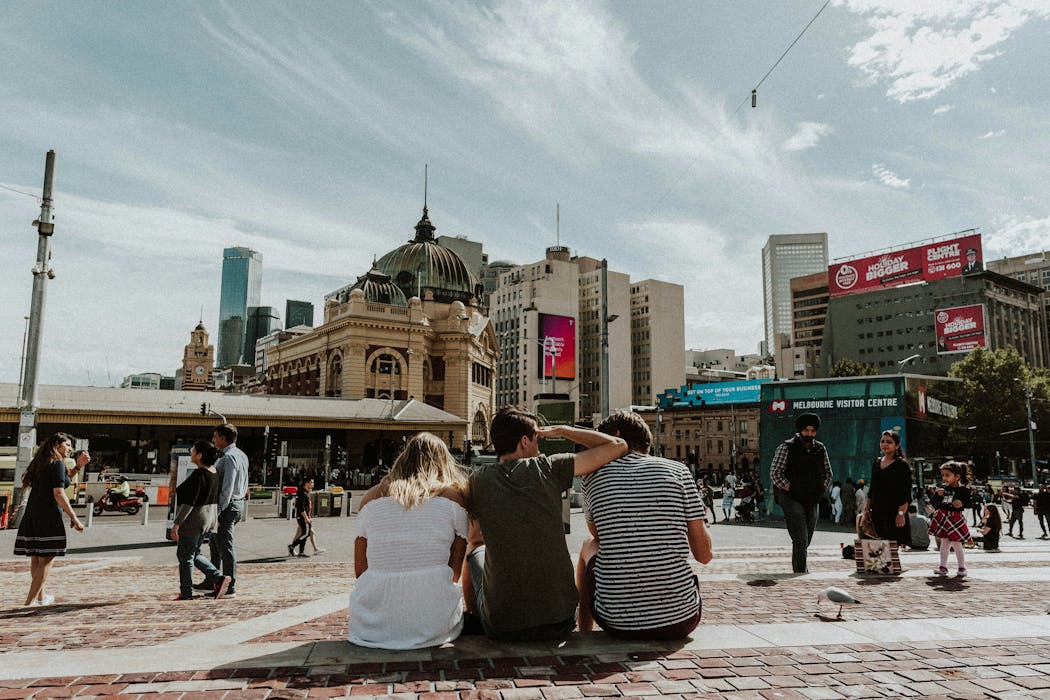
On Friday, thousands packed into Melbourne’s Federation Square for a free Amyl and the Sniffers show. Within minutes, fences buckled, the perimeter was breached, and the gig was cancelled over crowd crush fears.
It was gutting for fans – but it’s also the latest episode in a much longer fight over what, or who, Federation Square is really for.
A city that avoided gathering spaces
Melbourne’s uneasy relationship with civic squares goes back to the 1830s, when surveyor Robert Hoddle laid out the city grid without a major central square. This was a deliberate design choice to avoid the open plazas that elsewhere had become magnets for dissent and mass protest.

In the 19th and 20th century there were repeated failed attempts to retrofit a proper city square.
Proposals for a grand Parliament forecourt, for example, were abandoned in 1929 amid fears it would be used for protest.
City Square eventually opened in 1968 as a temporary design after the City of Melbourne acquired the land across from Town Hall. However, by 1997 it was carved up and sold off for the Westin hotel development, with much of its original design features (including a small waterfall) razed.
Federation Square, opened in 2002 on decking above rail yards, meant to fix our critical civic space gap. A publicly owned, privately operated space, the square blurred public place and commercial asset.
A focus on tourism and entertainment resulted in a square that often struggled to draw people in outside of events and beyond its surrounding venues, such as ACMI and NGV Australia.
In 2017, Fed Square’s management accepted a bid from Apple to demolish an existing building to erect their own flagship store within the square. This triggered fierce community backlash.
In response, Heritage Victoria listed Fed Square on the state heritage register – the youngest place ever to be listed. This limited development in the square, effectively putting a stop to the demolition plans.
The Heritage Council recognised the square as “the most important public square in Victoria”.
This flashpoint triggered a state government review into the square’s management, after which Fed Square was incorporated into the new Melbourne Arts Precinct Corporation in 2019. This brought a renewed emphasis on cultural programming. The irony, however: it has worked almost too well.
When you truly activate civic space, people show up. The Amyl gig proved relevant, exciting events draw crowds. But even with perfect crowd management, Fed Square – or any of Melbourne’s existing squares – simply couldn’t safely accommodate a crowd that size.
Lessons from Friday night
Fed Square has limited entry points and rigid borders: ideally, civic squares should have porous edges with lots of opportunities for spillover, or surrounding streets that can be closed to absorb crowds.
Melbourne’s rigid grid makes this difficult. As such, much of Melbourne’s public life has long been pushed into edge spaces – laneways, riverbanks, footpaths and markets, the State Library lawn (originally designed as a fenced off ornamental space, now inadvertently our most successful protest space following the removal of the picket fence).
This constraint has bred its own cultural innovation: Melbourne’s famed laneway culture emerged partly from necessity. And these diffuse, in-between spaces are genuinely valuable for everyday public life, not just mass gatherings.
But Friday shows we still need more opportunities for large-scale assembly. Other cities with established grids have managed it: Midtown Manhattan closed parts of Broadway to traffic; Barcelona’s Superilles (superblock) program created pedestrianised networks and new public squares within dense neighbourhoods.
Melbourne needs both large gathering spaces for moments like Friday night, and a diffuse network of everyday public spaces. That means seizing opportunities to create new civic plazas from major transport projects and renewal sites, protecting existing spaces like the State Library lawn and City Square from further privatisation, and challenging car dominance by closing more streets – temporarily or permanently.
If our only response to Friday night is tightening controls at Fed Square without also bolstering this diffuse cultural infrastructure – through planning protections, fairer regulation and investment in small venues (like Amyl and the Sniffers did themselves) – we will have missed the point.
Re-imagining public space
After a vexed history, rooted in a colonial planning logic that wanted to minimise gathering, Fed Square is slowly becoming the vibrant civic space people wanted. But we haven’t built the infrastructure to support that success.
People want to gather, but activating civic space without accommodating for growing demand is setting ourselves up for failure. We can’t just program better events; we need flexible crowd management systems, surrounding streets that can absorb overflow, and more public spaces.
Most importantly, we need to support the entire ecosystem – from Fed Square’s big stages to the small venues that quietly hold up Melbourne’s cultural life every night, and continue to carve out opportunities for public life.
Friday night proved Melburnians are hungry for public gathering. Now we need the civic infrastructure to match that appetite.
This article is republished from The Conversation, a nonprofit, independent news organization bringing you facts and trustworthy analysis to help you make sense of our complex world. It was written by: Rachel Iampolski, RMIT University
Read more:
- Amelia Earhart disappeared almost 90 years ago. Why are so many people still looking for her?
- A queer uprising 60 years before Stonewall: the 1905 Les Douaires riot
- How China spreads authoritarian practices beyond its borders
Rachel Iampolski received funding from Australian Government's Research Training Program as part of her PhD. She is affiliated with the Australian Greens Victoria.


 The Conversation
The Conversation
 People Human Interest
People Human Interest Battle Creek Enquirer Sports
Battle Creek Enquirer Sports CBS News
CBS News Week | 25 News Now
Week | 25 News Now KPAX
KPAX Washingtonian
Washingtonian The Northern Virginia Daily
The Northern Virginia Daily Associated Press Top News
Associated Press Top News KPTV Fox 12 Oregon
KPTV Fox 12 Oregon FOX 13 Tampa Bay Crime
FOX 13 Tampa Bay Crime AlterNet
AlterNet